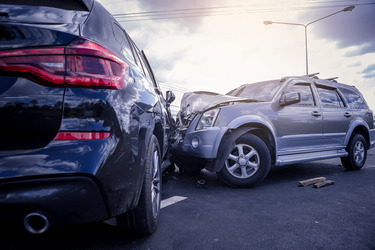
Vehicular collisions fall into several categories, including sideswipe, head-on, and rear-end collisions. There are T-bone collisions as well, or when the front of one car hits the side of another. Also known as side-impact accidents, they can cause a variety of injuries and typically call for legal action.
T-bone accidents are among the most fatal of their kind. Only head-on, or frontal, collisions are considered deadlier. In 2020, 23% of passenger vehicle accident deaths were a result of T-bone crashes.
T-bone collisions are common at intersections. For example, if a driver starts moving after the traffic light turns green and a car runs a red light and crashes into them, it is a T-bone collision. The colliding driver did not have the right of way and entered the intersection illegally.
These types of accidents can also occur on highways and roads if a driver loses control of their vehicle and impacts another. A driver might lose control of their vehicle for mechanical reasons, driver intoxication, distracted driving, drowsy driving, or poor road conditions. The latter reason can be due to weather, such as icy roads, or because of slippery substances like motor oil and gasoline.
Given the nature of T-bone accidents, it is possible for victims to sustain a variety of serious injuries. The most common include:
Whiplash
Whiplash occurs when the neck ligaments overextend from a vehicular impact, then violently snap back. Injury symptoms can manifest hours or even days later and include neck stiffness and pain, range of motion losses in the neck, pain when moving the neck certain ways, and tenderness in the shoulders, arms, and upper back. Symptoms can also include headaches that start at the base of the skull, arm numbness and tingling, dizziness, and fatigue.
Some individuals with whiplash experience symptoms such as ringing in the ears, blurred vision, irritability, sleep issues, depression, memory problems, and problems concentrating.
Concussions
Forceful side impacts can cause the brain to shake back and forth in the skull. Car occupants can suffer concussions; a type of traumatic brain injury that causes symptoms like headaches, dizziness, nausea, vomiting, ringing in the ears, fatigue, and blurry vision. Slurred speech, confusion, concentration and memory problems, and delayed responses to questions can occur as well.
Spinal Cord Injuries
T-bone car accidents can damage the spinal cords of the victims. Depending how the vehicle was hit, they might experience moderate injuries, such as one or more ruptured discs. Sadly, severe spinal cord injuries can cause degrees of paralysis, such as:
The severity of the paralysis varies by individual, with some people able to make partial or full recoveries.
Broken Bones, Burns, and Lacerations
Bone breaks and fractures, including severe compound fractures, can occur during a T-bone collision from the force of the impact. As with other T-bone injuries, the individuals on the side of the car closest to the colliding vehicle are most likely to sustain serious bone breaks. Most T-bone accident-related broken bones include the forearms, hands, legs, and ribs. If the vehicle rolls because of the force of the impact, the victims might sustain broken bones up and down their bodies.
Burn injuries can occur if the vehicle catches fire, such as second-, third-, and fourth-degree burns. Second-degree burns affect the epidermis and dermis, the top and underlying layer of skin, and cause symptoms such as blisters, tenderness, shiny and red skin, and swelling. Third-degree burns destroy two skin layers, causing the flesh to appear brown, white, yellow, or black. Because these burns affect nerve endings, they are not painful. Fourth-degree burns affect the muscles, bones, and tendons in addition to the skin and can be fatal.
Cuts and lacerations from flying auto glass, metal, and other debris are also common during T-bone and other vehicular accidents. The cuts and lacerations can appear on the face, head, neck, chest, arms, torso, hips, legs, and feet, depending on the nature of the accident.
It is possible to claim numerous damages following a T-bone car accident, including:
If the accident resulted in the victim’s untimely death, surviving family members can file a wrongful death lawsuit. In addition to the above damages, wrongful death suits typically include funeral or memorial costs, burial or cremation expenses, loss of companionship, and other damages.
When an accident is caused by a driver who intentionally harms someone or acted with a deliberate and flagrant disregard for the safety of others, it is possible for the victims to claim punitive damages. Punitive damages are a type of compensation that is awarded in addition to non-economic damages such as pain and suffering and economic damages. The purpose of punitive damages is to punish drivers for reckless behavior, like drunk driving.
Missouri allows plaintiffs to seek punitive damages in accidents caused by drunk or intoxicated drivers. While punitive damages are commonly awarded to victims of drunk driving accidents, it can be difficult to prove punitive damages to a jury.
No one should have to experience a T-bone accident. If you were injured in this type of collision, speak with a Kansas City car accident lawyer to learn your legal options as soon as possible.
